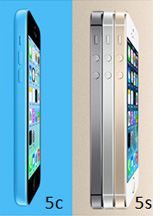Cheap iPhone Advocates Got It Wrong
By Tony Clark, 2-Dooz Inc. – October 17, 2013
 Readers of this blog know that I often look at strategic debates from the least advocated perspective. An example is a posting that I made in February of this year regarding expert calls for a cheap iPhone. Contradicting their calls, I concluded the entry by stating that Apple can afford to be deliberate about the introduction of a low cost model and by opining that any negative impact on the company’s margins due to such a device would be negligible. Meanwhile, the other side argued (and continues to argue) that a cheap iPhone is necessary for Apple to better compete with Samsung and that Apple has no choice but to provide the device in response to carrier partners’ desires to reduce subsidies. Fast forward eight months to today and several recent developments confirm that the advocates for a cheap iPhone got it all wrong.
Readers of this blog know that I often look at strategic debates from the least advocated perspective. An example is a posting that I made in February of this year regarding expert calls for a cheap iPhone. Contradicting their calls, I concluded the entry by stating that Apple can afford to be deliberate about the introduction of a low cost model and by opining that any negative impact on the company’s margins due to such a device would be negligible. Meanwhile, the other side argued (and continues to argue) that a cheap iPhone is necessary for Apple to better compete with Samsung and that Apple has no choice but to provide the device in response to carrier partners’ desires to reduce subsidies. Fast forward eight months to today and several recent developments confirm that the advocates for a cheap iPhone got it all wrong.
New iPhones
On September 10, 2013, Apple announced two new iPhone models: the 5c (where “c” means colorful and not cheap) and the 5s. In the iPhone lineup, the 5c essentially replaces the existing iPhone 5 and the 5s is the new flagship. Both phones come preloaded with iOS 7 and support a finger print scanner. The latter could play a key role in the enablement of smart phone based electronic payments.
Specific to the 5c, it has the same Apple A6 processor as the iPhone 5, has a higher resolution camera, and has a lower estimated cost of goods sold (COGS), thanks to a higher level of hardware integration. Overall, the 5c allows Apple to lower the price of the phone without negatively impacting its product margins.
Establishing a new performance benchmark at the highend, the 5s is the first to use Apple’s A7 processor and is the world’s first 64-bit smart phone in production. And, according to IHS, the 5s does this while achieving COGS that are on par with the old iPhone 5. This means that Apple can continue to enjoy historically high product margins with the 5s.
Moreover, Apple’s overall margins will likely improve and not shrink, as the proponents of a cheap iPhone argue, because it is now clear that in spite being the pricier of the two models, the new 5s is greatly outselling the new 5c. According to reports, some analysts estimate that the 5s could be outselling the 5c by more than a 2:1 margin. Given the power of Apple’s brand, this really should come as a surprise to no one.
World’s most valuable brand
Speaking of the brand, Interbrand recently revealed its “Best Global Brands 2013” list. And sitting atop the list for the first time and unseating Coca-Cola in the process is Apple. Interbrand noted, “Apple has set a high bar for aesthetics, simplicity, and ease of use that all other tech brands are now expected to match, and that Apple itself is expected to continually exceed.” An open question to all of those who still want Apple to do a cheap iPhone, is why after working so hard to build the world’s most valuable brand, would Apple jeopardize the accomplishment by obscuring the meaning of the brand with a cheap iPhone?
Staying the premium branding course
On October 14, 2013, Apple announced that Angela Ahrendts, CEO of Burberry, will be joining the company in the spring—reporting directly to CEO Tim Cook. Prior to Burberry, Ahrendts was executive vice president at Liz Claiborne Inc., and earlier in her career she served as president of Donna Karan International. Her appointment is noteworthy because Ahrendts will have oversight of the strategic direction, expansion and operation of both Apple’s retail and online stores. Moreover, given Ahrendts background, Apple is sending a clear signal that it is serious about maintaining the premium nature of its brand. The move should drive a nail in the coffin of any notion that the Apple brand will ever stand for “cheap.” Additionally, the appointment should counter any thoughts that Apple will cede control of user experience to the mobile carriers. This should allow Apple to continue to exercise leverage in their relations with mobile carriers and, consequently, should allow the company to continue resist pressure to lower their iPhone margins.
In light of the above, it is time for lingering calls for a cheaper iPhone to be put to rest.
Those are my thoughts. And, as always, I invite and look forward to learning what you think.
